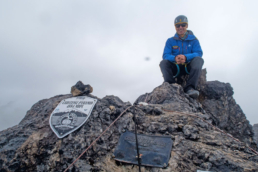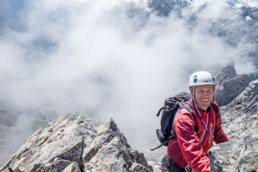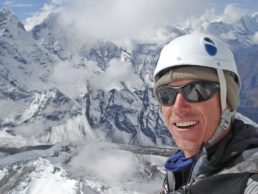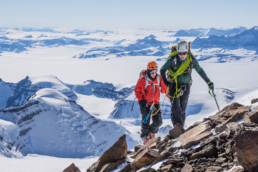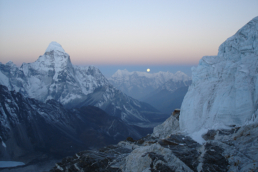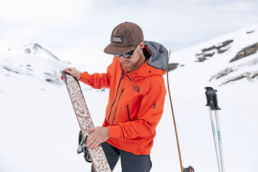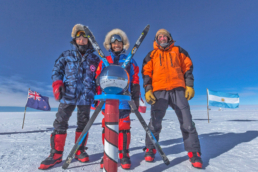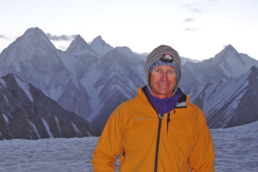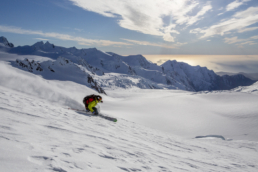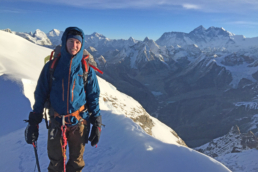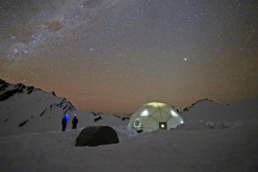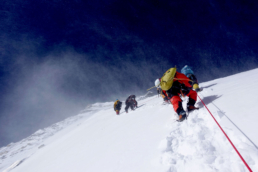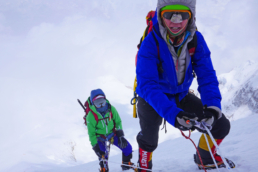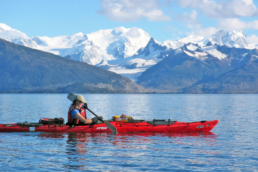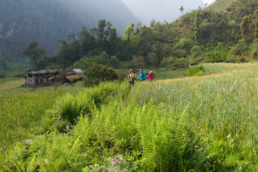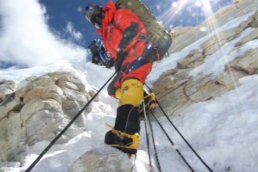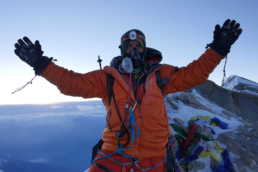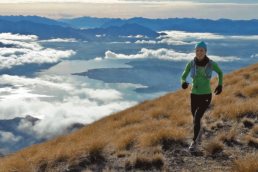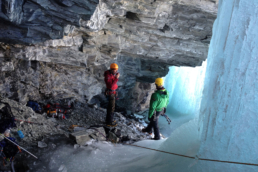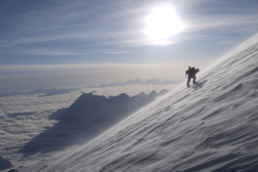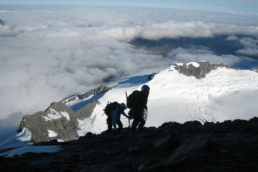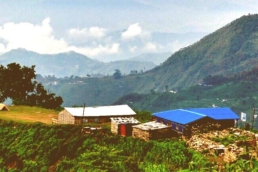Steve Moffat - A life guiding
As the sun sets on another busy southern summer season, we take a moment to put the spotlight on our New Zealand Operations Manager and long-term AC staffer, Steve Moffat. Steve’s guiding career is intricately interwoven with Adventure Consultants, spanning 18 years from his beginnings as an enthusiastic rookie to his recent ascension to New Zealand Chief Guide. As Steve embraces his new responsibilities within AC, we asked how it all began, where it’s going and what keeps one of our most popular guides coming back for more.
As a young teenager, Steve enjoyed a typical New Zealand progression into the outdoors—wandering into the hills, tramping with mates, camping in the middle of forests with a blackened billy on the fire and embracing all the classic trappings of a Kiwi coming of age. At school he was part of a rather unofficial school tramping club which soon gave him the skills to get well above the bush line and provided his first experiences with ice axe and crampons on the big glaciers.
No doubt his parents worried that his ‘wasted youth’ playing in the mountains was obstructing a solid career path. Little did they know that all that time spent on frivolous behaviours would set him up for a life of rewarding alpine adventures. It was a path that eventually led him to work on the Aoraki Mount Cook Search & Rescue team. Suddenly immersed in a world of alpine professionals, a latent interest began to bud. Spurred on by a personal mountaineering trip to the Peruvian Andes, Steve returned to New Zealand, where it seemed a natural progression to see “what this guiding lark was about”.
With the pre-requisites for the guide training scheme already completed, Steve found his work opportunities abundant and a move to Wanaka in the late nineties saw his first connection with Adventure Consultants as a freelance guide. Not looking back, by 2002 Steve had been reeled in full time and a year later was away on his first AC expedition to climb Ama Dablam. It was Steve’s first visit to Nepal, offering a spectacular introduction to Himalayan climbing and the challenges of guiding at high altitude. From then on it was all go, with this proving the first of many high-altitude forays he would guide, amongst which Cho Oyu, Island Peak, Lobuche East, Kyajo Ri, Aconcagua, Carstensz Pyramid, Greenland skiing and the big one itself, Mount Everest.
Standing out above Steve’s many expedition experiences have been his trips to Antarctica, fulfilling a childhood dream to visit the White Continent. As a young lad, long before he was thinking about a life of guiding, Steve would devour any book on the frozen south that he could lay his hands on. Absorbing the history of early exploration and captivated by how wild, remote, huge and inaccessible the continent was, the idea fascinated him. Certainly, it lived up to Steve’s expectations as he has now been down to guide expeditions to Vinson Massif on multiple occasions.
Today Steve splits his working life between the office and still getting time in the great outdoors, embracing his additional new role as New Zealand Chief Guide and the challenge of keeping the New Zealand ship running smoothly. It’s been this balance of his mostly office-based operational role with the early alpine starts on wild peaks that has allowed Steve to maintain a fresh outlook and passion for guiding over the years. There’s a lot to balance! In between home life, family, friends, international expeditions, New Zealand summer mountaineering, winter skiing and ice climbing, you’ll likely find Steve scratching away on cragging routes up the beautiful Matukituki Valley or dipping his toes into the cold Southern Ocean in an attempt to catch a wave or two.
In addition to the operational work that Steve undertakes overseeing the safety and management of our New Zealand program, his new position will see him establish an even closer relationship with the AC guides, working with them on their training and ongoing professional development. He’s their go-to for questions and support, with pre-winter guides’ training the next big focus. It’s here that Steve’s easy-going nature comes to the fore, as his good relationships with the guides keep the best coming back season after season.
Steve explains that there seems to be no slowing down of the industry in sight, opening up more and more opportunities for the current generation to expand their horizons beyond traditional routes up classic mountains. It’s entirely possibly to incorporate year-round guiding with the greater ranges around the globe, allowing modern guides to introduce new and exciting chapters into their CVs and really focus on the types of climbing and skiing on which they thrive.
For Steve, it’s been all about the special people you meet along the way, some of whom become lifelong friends. One of these standouts is Jack Green, with whom Steve first climbed in his early guiding days, fresh out of his initial guide assessments. Jack was then in his early 60s (“the new 40s these days, eh”) and already with a background in quality British scrambling routes. Over a period of three seasons, Jack joined Steve on numerous mountain adventures, high on the Fox and Franz Josef Glaciers, on Mount Aspiring and on sojourns to Fiordland’s Darran Mountains. A highlight for them both was reaching the summit of Mount Tasman via the North Shoulder with Jack at the tender age of 63. Jack dropped in to see Steve a while back and although fifteen plus years may have flown by, Steve admits: “It’s guys like Jack that keep me passionate about taking people into the high mountains. It’s more than summits, it’s experiences with great people in special parts of the world”.
With Steve himself currently planning winter ice climbing and ski touring missions, there is rarely a dull moment.
“Just keep the coffee pot full”
Related Posts
November 27, 2020
How to Climb Your First 6,000m Peak
March 19, 2020
Gear Review: The North Face Futurelight Jacket
October 7, 2019
Mind Over Mountains
September 29, 2019
EXPLORING THE UPPER MUSTANG
August 26, 2019
The Call of the Mountains
August 4, 2019
Glacier Ski Touring
May 30, 2019
Fixing Everest – Part 2
May 29, 2019
Everest Base Camp Kitchen
October 8, 2018
Magnificent Mera
September 14, 2018
Welcome to The Geo Dome
July 13, 2018
Everest Insider Series: James Perry
July 5, 2018
Everest Insider Series : Anthea Fisher
June 20, 2018
Everest Insider Series : Doctor Sophie Wallace
May 9, 2018
Mettle and Grit High on Nuptse
February 22, 2018
Define Failure
January 10, 2018
Optimum Layering
November 8, 2017
The North Face Adventure Grant 2018
September 10, 2017
Fit To Trek
August 14, 2017
Boots For The Mountains
July 28, 2017
The North Face Inferno Sleeping Bag
May 30, 2017
Fit To Climb
March 27, 2017
An Ice Climbing Adventure
March 1, 2017
The Go Big, Go High Adventure Calendar
February 16, 2017
Claiming False Summits
November 16, 2016
So They Can
November 9, 2016
Return to Tititea
November 3, 2016


